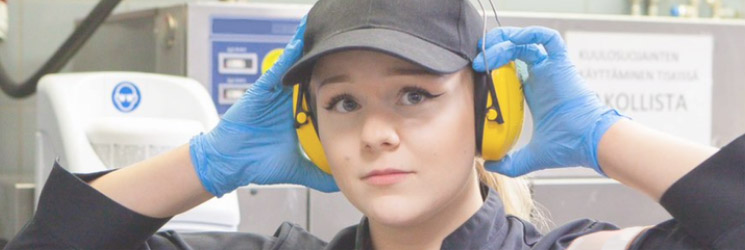

Working conditions
Limit values
The limit values for work-related exposure should be taken into account when doing risk assessments in the workplace. Exposure limit values have been set for concentrations of pollutants in workplace air and for biological exposure indicators. Limit values are set both at national and EU level, and they have different roles in legislation. Occupational exposure limit values can be either binding or non-binding. The occupational exposure limit value of a substance must be stated in the safety data sheet (section 8.2).
Binding limit values
Binding limit values have been set for some air pollutants present in the workplace. There are binding limit values for asbestos, lead, and air impurities. The limit value may not be exceeded. If the limit is exceeded, the employer must immediately reduce the exposure level so that the limit will not be exceeded again.
Detailed information on binding limit values can be found in Government degree about cancer-causing, genetic-damaging and reproduction-dangerous factors at work 113/2024 (in finnish).
Asbestos
Asbestos refers to fibrous silicate minerals. As asbestos can cause cancer, special requirements have been defined for handling it. More information on this is available on the page Asbestos. The limit for employee exposure is 0.1 fibres/cm3, whereas the limit value for asbestos in the work environment is 0.01 fibres/cm3.
Lead
The monitoring of workers’ exposure must include the measurement of lead concentration in blood (B-Pb) with atomic spectroscopy or another method that gives equivalent results. The binding biological limit value is 500 micrograms of lead per litre of blood.
If the lead concentration of a worker’s breathing air exceeds 0.015 milligrams per cubic metre, calculated as a time-weighted average over a period of 40 weeks, or if even one worker’s blood lead concentration is 400 micrograms per litre or more, the employer must particularly monitor the lead content in the air of the workplace, the lead content in the worker’s blood and the potential health hazards caused by lead.
Concentrations known to be harmful (HTP values)
Concentrations known to be harmful (also known as HTP values) are limits estimated by the Ministry of Social Affairs and Health for the lowest concentrations of pollutants which can pose a risk or hazard to the safety, health or reproductive health of employees. They have been established by a Decree of the Ministry of Social Affairs and Health under the Occupational Safety and Health Act. Employers must take the HTP values into account when analysing employee exposure and measurement data during the assessment of occupational hazards and the planning of the work environment.
Publication HTP Values 2025 (in Finnish). Ministry of Social Affairs and Health.
The HTP value states the concentration of a substance within the breathing zone. In the case of all-day exposure, eight-hour average concentrations should be indicated. If the substance has acute effects or if the exposure time is short, even shorter exposures should be analysed. Whenever possible, the sampling time must be no more than 15 minutes, which is in line with the reference time for HTP values.
The HTP values are prepared by the HTP Division operating under the Advisory Committee on Preparation of Occupational Safety Regulations with possible help from experts. The preparation of these values (the drafting of explanatory memorandums) involves an overview of literature and research data about the substance or group of substances in question in order to propose an HTP value for the substance or group of substances.
The explanatory memorandums for HTP values are listed in Finnish in alphabetical order on page Explanatory documents.
Limit values for biological exposure indicators
Biomonitoring refers to the assessment of the chemical body burden or the assessment of a recent exposure to a chemical. It also involves the assessment and monitoring of exposure-related health risks by analysing biological samples.
Biomonitoring is usually done by collecting blood or urine samples from employees to analyse the chemical and its metabolites in the body. Biomonitoring takes all routes of exposure into account: the skin, the respiratory tract and the digestive tract. Analysing total exposure is essential when assessing exposure and the health risks resulting from exposure to substances which are absorbed through skin in significant amounts or which accumulate in the body due to continuous and repeated exposure. Biomonitoring can be used to supplement the results of workplace air pollution measurements.
Biomonitoring data is compared to indicative values. The Finnish Government has set a binding limit value for blood lead levels, and the Ministry of Social Affairs and Health has determined indicative limit values for other substances in line with the limit value, or HTP value, for workplace air pollutants. The indicative limit value corresponds to an eight-hour exposure at a level known to be harmful (HTP level).
These indicative limit values have been defined for arsenic and inorganic arsenic compounds, mercury and inorganic mercury compounds, ethyl benzene, phenol, chromium (VI) compounds, xylene, lead and inorganic lead compounds, 4,4'-methylenebis(2-chloroaniline) (MOCA), carbon disulphide, styrene, tetrachloroethylene, toluene and trichloroethylene. The limit values can be found in the publication HTP Values 2020 by the Ministry of Social Affairs and Health.
Legislation
Government degree about cancer-causing, genetic-damaging and reproduction-dangerous factors at work 113/2024 (in finnish)
Government Decree on the Safety of Asbestos Work (798/2015)
Decree of the Ministry of Social Affairs and Health on Concentrations Known to be Harmful (654/2020, in Finnish), is repealed as of 1 March 2025 by Decree of the Ministry of Social Affairs and Health on Concentrations Known to be Harmful (55/2025, in Finnish)

